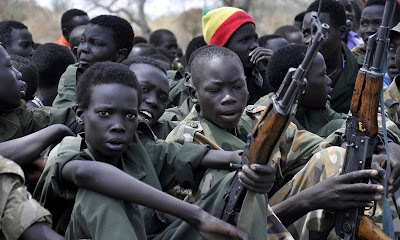Photo: Amo Tiffani
Article 3 paragraph (b) of the Protocol to Prevent, Suppress and Punish Trafficking in Persons defines trafficking but for ease of understanding the following summarizes the definition in three components:
The Act (What is done)
Recruitment, transportation, transfer, harboring or receipt of persons
The Means (How it is done)
Threat or use of force, coercion, abduction, fraud, deception, abuse of power or vulnerability, or giving payments or benefits to a person in control of the victim
The Purpose (Why it is done)
For the purpose of exploitation, which includes the exploiting the others for the purpose of commercial sex work, sexual exploitation, forced labor, slavery or similar practices and the removal of organs.
Victims of trafficking are coerced, or overtly deceived into thinking they are obtaining legitimate jobs as miners or as restaurant, construction and domestic workers. While in the case of many children and adolescents, parents believe they are sending their children to safe havens from war, conflict and economic crisis to be cared for by distant relatives or family friends. Often these children are used to work on farms or as errand boys and girls in restaurants. In the worst cases they are forced into commercial sex work---both girls and boys. Photo: Hawaii Independent
.
In the United States, many child and adolescent runaways are trafficked into commercial sex work in hotels, during sporting events and large conferences. According to the article “Women the new pimps in human trafficking trade,” women emerged in 2009 to be the largest group of perpetrators in human trafficking. Women are often deemed to be more “caring” and “protective.” Thus many individuals and/or parents in developing nations do not think about the hidden motives of why they may be offering to help alleviate their problems with “work or safety abroad” for themselves or their children. When trafficked, victims have no contact with the outside world, their passports and other legal identifying documents are taken from them and they are often threatened with extreme forms of violence and death if s/he attempts to contact others for help or to escape. A trafficking victim in many situations is the slave of their “employers” as they depend on them for everything from food, medicine and shelter.
Many individuals never report being trafficked, even if and when they are able to escape, thus it makes it very difficult to calculate the exact number of victims of human trafficking. What many advocates know is that there could be as many as millions of victims of human trafficking, while the number of survivors (those who escape AND report that they had been trafficked) is in the hundreds of thousands. According to the 2014 Global Slavery Index, “around the world today, there are an estimated 35.8 million men, women and children trapped in modern slavery.”
According to the UN Information Service (UNIS), human trafficking negatively impacts development in several ways: “Bribery and corruption, organized criminal gangs of traffickers undermine governments and the rule of law. In addition, human trafficking comes at a high cost for the economy: reducing tax revenues and migrant remittances. It shatters the social fabric of communities: family ties and communities are destroyed, children are denied an education, and public health problems such as HIV/AIDS may be perpetuated.”
Border control points in developing countries are major sites for trafficked girls and women experiencing sexual exploitation
Photo: News Day Zimbabwe
Each year the U.S. Department of State issues a Trafficking in Persons (TIP) Report that ranks various countries at risk of being source and/or destination countries of human trafficking. The tier system starts at Tier 1, the best, to Tier 3, the worst. In 2014 South Sudan was ranked Tier 2 but has subsequently moved to Tier 3 in 2015. According to the 2015 Tip Report, South Sudan is both a source and destination country for men, women, and children subjected to forced labor and sex trafficking. South Sudanese women and girls, particularly those from rural areas or who are internally displaced, are vulnerable to domestic servitude. Some girls as young as 10 years old, are subjected to sex trafficking in restaurants, hotels, and brothels in urban areas. Children working in construction, market vending, shoe shining, car washing, rock breaking, brick making, delivery cart pulling, and begging may be victims of forced labor as well as being forced into commercial sex work. While women and girls from Uganda, Kenya, Ethiopia, Eritrea, and the Democratic Republic of the Congo migrate willingly to South Sudan with the promise of legitimate work but once they arrive to South Sudan they are subjected to various forms of sexual and labor exploitation.
In 2014, trafficking of children increased in South Sudan particularly in the "recruitment" of child soldiers. According to the 2015 TIP report, the SPLA’s recruitment and use of child soldiers, often by force, increased considerably, with approximately 12,000 child soldiers within the SPLA, as well as in armed opposition groups in South Sudan. Most child soldiers were between 15 and 16 years old, but some were as young as 11. In addition the 2015 TIP report states that 23 girls were found working as servants in the Sudan People’s Liberation Army (SPLA) military barracks in Upper Nile state. In February 2015, the TIP report notes the SPLA-in opposition (SPLA-IO) also recruited a large number of children to be soldiers. The 2015 TIP reports states that 9,000 child soldiers, were recruited by the White Army, which is affiliated with the SPLA-IO with some children participating in active fighting.
Photo: Guardian News
Human trafficking occurs in the United States as a destination country for trafficked persons from other countries. It is also a source country, with persons trafficked within the country, especially children/adolescents living and working on the street. If you are interested in organizations working on anti-trafficking initiatives you can access Humantrafficking.org, a web resource for combating human trafficking.





Where are you now, Esha G? Your blog stalled - I miss you.
ReplyDelete